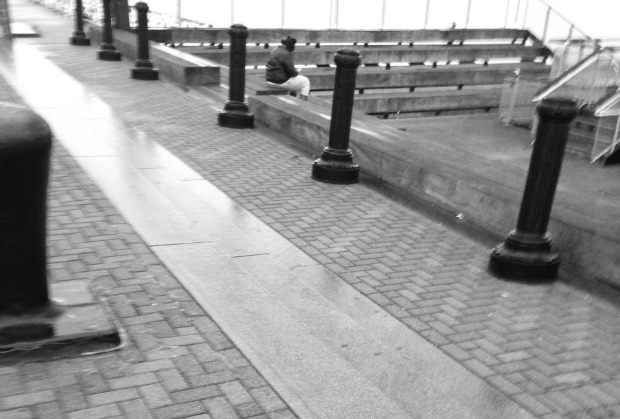You have no items in your cart. Want to get some nice things?
Go shopping
“There used to be offices up there and some of the people would stand there, would stand at those windows and look down at the people, like they were looking down at the people. I didn’t like that.”
Tamika walks slowly with a slight limp. A deep cough quakes her chest, shaking her entire body. She is African-American, about 5’4 and appears to weigh over 250 pounds. Her skin is russet in color and her large, round eyes are a deep shade of coffee. She is missing some front teeth.
Tamika is wearing blue jeans and a worn orange sweater that appears unclean. On her feet, the Yonkers resident is wearing faded black socks and inexpensive faux leather sandals. Her hair is tied with a bandana, underneath a winter cap. She removes the cap and bandana briefly, exposing a few errant hairs along her temples and grown-out relaxed, light brown roots. At one point in her life, Tamika says, she was a foster child.
She mostly keeps to herself when visiting the shelter, only associating with a handful of people–although she is quite friendly.
“You don’t know what the hell is wrong with some people,” she says. “Everyone got their own problems. Plus no one really takes the time to listen.”
Tamika draws inspiration for conversation from signs and objects in the lunchroom: “go before you show” a sign on the health center door, the arrangement of tables, what doors lead to where in the facility. She discusses her hair and wanting to get her nails done. One of these days she says, she will. She also talks about the 1970s, parties and relatives she hasn’t seen since.
“They must be dead or something,” Tamika says flatly. “Haven’t seen most of them since the 70s. Yeah–they all probably dead.”
Her mood shifts. She switches topic and begins to talk about Thanksgiving. “This year, I’m gonna have barbecue turkey, macaroni and cheese, collard greens. Probably some white potatoes and some sweet potatoes. It’s just gonna be me this year.”
Although the shelter helps women, its primary concern is homeless men. Women are referred to other agencies, as the city only has one shelter for females: the YWCA. Still, The Sharing Community runs a Women’s Initiative Program that helps with issues such a domestic violence, health.
According to Alex, a case worker at the shelter, most of the women who come to the shelter have been through a lot. And many of the women who come to the shelter have also been in foster care.
“They’re the worst ones in here,” he says. “If they’re really pretty, I try to talk to them and get ‘em out of here as soon as I can. If guys see them, they’ll try to go be with them, take advantage.” He says in the past, women have been robbed, bribed—among other things.
***
Tamika moved to southwest Yonkers, New York in 1978. She was born 10 years after the Brown v. Board of Education case, three years following the Supreme Court order to integrate New Rochelle’s Lincoln School, in 1966. Eight years before she was born, the Addict Rehabilitation Center (ARC) began in the basement of a church in Harlem. Since then, the facility has become the oldest and largest drug treatment program in New York State.
In the 1990s, according to public records, ARC would play an important role in Tamika’s life.
“When I was 11, I was friends with Candi Staton’s sister – you know, [Candi Staton] did the song “Young Hearts, Run Free” in the ‘70s,” she says. “Her sister once had a homecoming party and my foster mother wouldn’t let me go. She was a witch.”
Tamika continues to talk about the ‘70s: more parties and old friends. Her pupils widen and her body relaxes, easing into a state of transcendence.
Yonkers, 1978. Judge Leonard B. Sand–a key figure in the desegregation of Yonkers’ schools and the implantation of more affordable housing in the city–had recently been appointed to the bench by President Jimmy Carter. And it was a year after David Berkowitz – the Son of Sam – was arrested outside his apartment in Yonkers, at 35 Pine Street.
Tamika had previously attended Daniel Webster Elementary School and was scheduled to enroll in Albert Leonard Junior High School, but moved before she had the chance. The school – one of only two public junior high schools in the city – is located on the north side of the city and, at the time, was mostly attended by white middle and upper-class residents.
“I really wanted to go to Albert Leonard,” she says. The unrequited sadness of uncovered memory resonates.
Instead, she went to Longfellow Junior High School – now abandoned – in southwest Yonkers, on Mulberry Street. The roof of the school has partially caved in, with small trees sprouting out of the missing concrete. Almost all of the windows have been shattered; the wooden boards that cover the entrance ways have decayed. There is a rusted fence surrounding the perimeter and graffiti on the outside walls.
***
In 1983, Tamika graduated from Yonkers High School. In her black and white high school year book photo, she is wearing small earrings and has earlobe-length hair, parted to the side. A wide smile shows her straight teeth and a black drape is styled around her shoulders, revealing her clavicle and a thin necklace. Under her photo, she did not list any hobbies, future plans or any inspiring quotes – things typically found in high school yearbooks.
After graduating high school, Tamika did not go to college. In the years that followed, she probably had many dates: movies at Yonkers’ Park Hill Theater—“Rocky IV” and “The Color Purple.” Or late nights hanging out at the city’s JFK Marina–a once desolate park filled with trash and abandoned cars, along the Hudson. There were probably boys, maybe girls, all from the neighborhood, similar socioeconomic circles. Some Colt 45s and a pack of Kools: her in an acid-washed skirt inside an IROC-Z. It’s possible Tamika made numerous trips to the Cross County Shopping Center, perhaps for a Members Only jacket, a Swatch watch, some Guess jeans.
During the next few years, she says, she worked at various factories near Yonkers: Frito Lay, Pepsi and Stella D’oro in the Bronx. But with the decline of industrialization, many factories shut down or substantially shrunk their work force, causing low-skilled employees like Tamika to find jobs elsewhere. From 1985-1988, for every 10 workers, eight were displaced; their average age was between 25 and 54.[1] It’s probable that Tamika was one of these employees.
Fired or otherwise, it is likely that Tamika floated from job-to-job, trying to make ends meet: she became another nameless casualty in the war between supply and demand. She may or may not have stayed with a friend or two, possibly some relatives—all likely lived in Yonkers’ southwest. Feeling the strain of an extra mouth to feed, on an already tight budget, Tamika could have been a burden.
Or she could have gotten married or moved in with a boyfriend—or girlfriend—possibly had some children. Loss of job, loss of apartment—with a child or children and a partner in tow. There may have even been abuse.
Regardless, Tamika does not discuss the time period post high school through the 1990s whatsoever.
“People be lookin’ at me like I ain’t worked,” she says. “I worked. I just didn’t stay at the jobs long, you know? But I worked.”
In the later portions of the 1980s and early 1990s, according to public records, she also moved around the county, living in Ossining, Peekskill and Elmsford. At one point, she lived in an apartment a few blocks away from Sing Sing Correctional Facility.
“I gotta get my life together,” she says with a sigh. “It’s like I just been standing still. I haven’t been motivated to do nothing, you know?”
Tamika says she knew she wouldn’t have her rent money almost two weeks ago and had only recently mustered the energy to come down to The Sharing Community homeless shelter to try and get some help. She didn’t pay her rent because she spent all of her money on lotto tickets: she and a friend bought the tickets at a local convenient store. In an attempt to change her luck, she secretly swapped tickets with the friend, who won $400. Tamika won nothing, although her friend, feeling bad, gave her $20. She is now broke.
According to Tamika, welfare can’t help her with her rent this month because it paid her rent last month; she received a “one shot deal” the previous month from social services. Regardless, the deadline to pay her rent is October 19 – the following day.
“I waited ‘til the last minute,” she continues. “I fucked up. I can’t be doing this. I fucked up.”
A male case worker interrupts Tamika and tells her she has to go to Catholic Charities to fill out an application for the nonprofit to help her because she lives in municipal housing. She is unsure of how to get there.
“You gotta walk,” he says. “It’s right down the block.” He points toward the street.
“Can’t they mail me an application?”
“No,” he says. “You have to go in person.” She walks out of the shelter. The case worker begins talking to a female co-worker after Tamika leaves.
“She’s gotta learn some responsibility,” the male case worker says, shaking his head.
“She only receives $80 a month.”
“But if DSS pays her rent,” he continues, “how is she going to pay her other bills?”
They continue to discuss Tamika’s case for a few minutes before heading back toward the lobby, toward stacks of files similar to Tamika’s.
[1] “Displaced Workers: 1985-1989,” by Diane E. Hertz, United States Bureau of Labor Statistics.


About Rachel McCain
Rachel McCain is an MFA candidate at Sarah Lawrence College in Bronxville, New York. She has written for The Source Magazine and previously served as deputy editor of Home Town Media Group, a small community newspaper company in New York. Currently, Rachel working on a nonfiction book manuscript. For more information, visit Rachelmccain.net.



